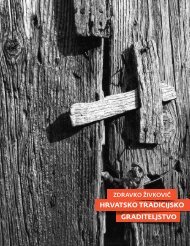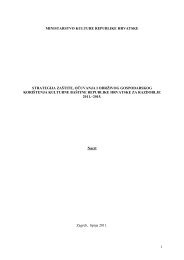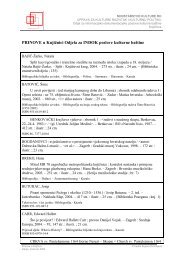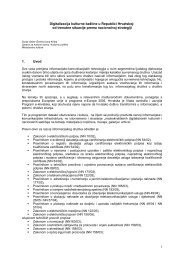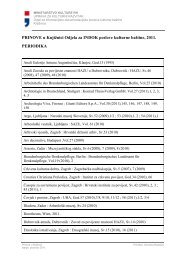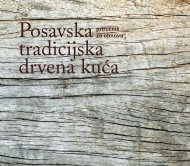Gašpina mlinica u Solinu - Ministarstvo kulture RH
Gašpina mlinica u Solinu - Ministarstvo kulture RH
Gašpina mlinica u Solinu - Ministarstvo kulture RH
Create successful ePaper yourself
Turn your PDF publications into a flip-book with our unique Google optimized e-Paper software.
196 | Godišnjak zaštite spomenika <strong>kulture</strong> Hrvatske 33/34-2009./2010.<br />
(2004.): Non-destructive XRF analysis of paintings, Nuclear<br />
Instruments and Methods B, 226:53-59, London Oxford<br />
Moioli, P. Seccaroni, C. (2000.): Analysis of art objects using<br />
a portable x-ray fluorescence spectrometer, X-Ray Spectrometry,<br />
29:48-52, Chichester<br />
Karydas, A.K., Kotzamani, D., Bernard, R., Barrandon,<br />
J.N., Zarkadas, Ch. (2004.): A compositional study of a<br />
museum jewellery collection (7th–1st BC) by means of<br />
a portable XRF spectrometer, Nuclear Instruments and<br />
Methods B, 226:15-28, London, Oxford<br />
Cesareo, R., Castellano, A., Buccolieri, G., Marabelli, M.<br />
(1999.): A portable apparatus for energy-dispersive X-ray<br />
fluorescence analysis of sulfur and chlorine in frescoes<br />
and stone monuments, Nuclear Instruments and Methods<br />
B, 155:326-330, London, Oxford<br />
Desnica, V., Škarić, K., Jembrih-Simbuerger, D., Fazinić, S.,<br />
Jakšić, M., Mudronja, D., Paviličić, M., Peranić, I., Schreiner,<br />
M. (2008.): Portable XRF as a valuable device for preliminary<br />
in situ pigment investigation of wooden inventory<br />
in the Trski Vrh Church in Croatia, Applied Physics A<br />
- Materials Science and Processing, 1 (92):19-23, Goettingen<br />
Jakšić, M., Radović, I.B., Bogovac, M., Desnica, V., Fazinić,<br />
S., Karlušić, M., Medunić, Z., Muto, H., Pastuović, Ž., Siketić,<br />
Z., Skukan, N., Tadić, T. (2007): New capabilities of<br />
the Zagreb ion microbeam system, Nuclear Instruments<br />
and Methods B, 261:541-545, London ,Oxford<br />
Desnica, V., Furic, K., Hochleitner, B., Mantler, M. (2003.):<br />
A comparative analysis of five chrome green pigments<br />
Summary<br />
MOBILE DEVICE FOR X-RAY FLUORESCENCE<br />
ANALYSIS (XRF) AS A UNIQUE INSTRUMENT FOR<br />
IN SITU ELEMENTAL CHARACTERIZATION OF<br />
CULTURAL HERITAGE GOODS<br />
This paper deals with the advantages of using the portable device<br />
for X-ray fluorescence analysis – XRF, as the first step in the in situ<br />
characterization of materials on cultural heritage objects. XRF is a<br />
method based on stimulating atoms of the examined sample by<br />
X-rays resulting in the emission of fluorescence radiation from the<br />
material characteristic for the element composition. This information<br />
gives us both a qualitative as well as quantitative indication of the<br />
elemental composition of the sample.<br />
XRF is a non-destructive, universal and relatively simple analytical<br />
method for the multi-elemental analysis of artefacts and as such<br />
is generally perceived as one of the most basic physical research<br />
methods in the conservation-restoration field. In its portable form,<br />
used in this work, this technique was also non-invasive and only<br />
based on different spectroscopic techniques, Spectrochimica<br />
Acta Part B, 58:681-687, London, Oxford<br />
Feller, R.L., Roy, A., FitzHugh, E.W., Berrie B. (2007.): Artists’<br />
Pigments, A Handbook of Their History and Charactersitics,<br />
Vol. 1-4, Washington, Oxford<br />
Mudronja, D., Jakšić, M., Fazinić, S., Božičević, I., Desnica,<br />
V., Woodhead, J., Stos-Gale, Z. (2010.): Croatian Appoxiomenos<br />
alloy composition and lead provenance study,<br />
Journal of archaeological science, 37 (7):1396-1402, London,<br />
Oxford, Toronto<br />
Ingo, G.M., De Caro, T., Riccucci, C., Angelini, E., Grassini,<br />
S., Balbi, S., Bernardini, P., Salvi, D., Bousselmi, L.,<br />
Çilingiroğlu, A., Gener., M., Gouda, V.K., Al Jarrah, O.,<br />
Khosroff, S., Mahdjoub, Z., Al Saad, Z., El-Saddik, W.,<br />
Vassiliou, P. (2006.): Large scale investigation of chemical<br />
composition, structure and corrosion mechanism<br />
of bronze archaeological artefacts from Mediterranean<br />
basin, Applied Physics A - Materials Science and Processing,<br />
83:513-520, Goettingen<br />
Craddock, P.T. (1976.): The composition of copper alloys<br />
used by the Greek, Etruscan and Roman civilizations.<br />
1. The Greeks before the Archaic period, Journal of Archaeological<br />
Science, 3:93-113, London, Oxford, Toronto<br />
Craddock, P.T. (1977.): The composition of the copper alloys<br />
used by the Greek, Etruscan and Roman civilizations.<br />
2. The Archaic, Classical and Hellenistic Greeks, Journal<br />
of Archaeological Science, 4:103-123, London, Oxford,<br />
Toronto<br />
those problems that were not solved by this method in the field<br />
were analyzed additionally with the use of specialized laboratory<br />
equipment. Therefore, the XRF results from the field also serve as<br />
valuable guidelines for the further systematic and targeted taking<br />
of samples reducing thus the need for sample taking to a minimum.<br />
This feature is of special importance when dealing with the investigation<br />
of valuable and unique objects, which is almost a rule in this field.<br />
The advantages, merits and benefits of this method have been demonstrated<br />
on a number of examples from practice on which the<br />
author of this paper worked and which include the field investigation<br />
of the pigments of wooden polychromy in the Church of St. Mary<br />
of Jerusalem in Trški Vrh and determining the composition of the<br />
alloy of the sculpture of the Croatian Apoxiomen.



